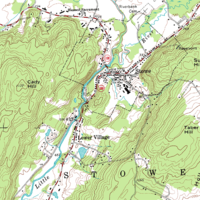
Photo from wikipedia
The paramount importance and multi-purpose applications of underlying topography over forest areas have gained widespread recognition over recent decades, bringing about a variety of experimental studies on accurate underlying topography… Click to show full abstract
The paramount importance and multi-purpose applications of underlying topography over forest areas have gained widespread recognition over recent decades, bringing about a variety of experimental studies on accurate underlying topography mapping. The highly spatial and temporal dynamics of forest scenarios makes traditional measuring techniques difficult to construct the precise underlying topography surface. Microwave remote sensing has been demonstrated as a promising technique to retrieve the underlying topography over large areas within a limited period, including synthetic aperture radar interferometry (InSAR), polarimetric InSAR (PolInSAR) and tomographic SAR (TomoSAR). In this paper, firstly, the main principle of digital elevation model (DEM) generation by InSAR and SAR data acquisition over forest area are introduced. Following that, several methods of underlying topography extraction based on InSAR, PolInSAR, and TomoSAR are introduced and analyzed, as well as their applications and performance are discussed afterwards. Finally, four aspects of challenge are highlighted, including SAR data acquisition, error compensation and correction, scattering model reconstruction and solution strategy of multi-source data, which needs to be further addressed for robust underlying topography estimation. 近几十年来,森林覆盖区林下地形的重要意义与应用已得到广泛认可,许多学者对此开展了大 量高精度林下地形绘图的研究。然而,森林场景的高时空动态性使得传统的测量技术难以重建精确的 林下地形。微波遥感为林下地形测绘带来了契机,其能在有限的时间内大范围提取、重建林下地形, 其中包括合成孔径雷达干涉测量(InSAR) , 极化合成孔径雷达干涉测量(PolInSAR) 和层析 SAR(TomoSAR)。本文首先介绍了基于InSAR 生成数字高程模型(DEM)的主要原理以及森林区域SAR 数据的获取。随后,综合分析了基于InSAR,PolInSAR 和TomoSAR 的林下地形提取方法,并讨论其 相关的应用及反演性能。最后,重点介绍了未来高精度林下地形测绘所面临的四个方面的挑战,包括 SAR 数据采集,误差补偿和校正,散射模型重建与解译以及多源数据融合的解决方案与策略。
Journal Title: Journal of Central South University
Year Published: 2020
Link to full text (if available)
Share on Social Media: Sign Up to like & get
recommendations!